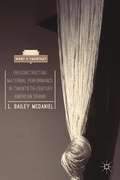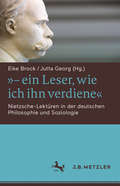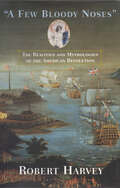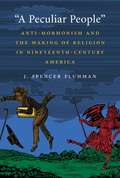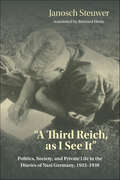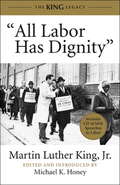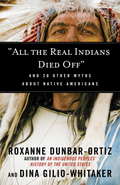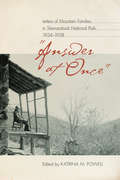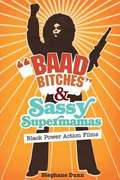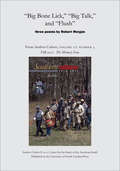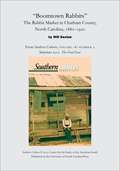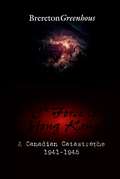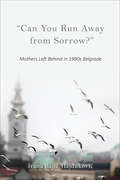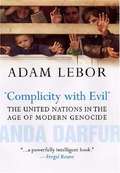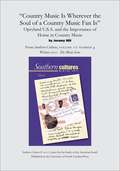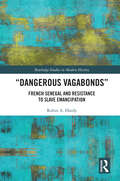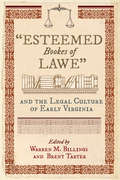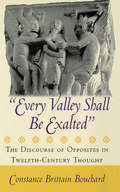- Table View
- List View
(What is Theatre?)
by L. Bailey McDanielLooking at a century of American theatre, McDaniel investigates how race-based notions of maternal performance become sites of resistance to cultural and political hierarchies. This book considers how the construction of mothering as universally women's work obscures additional, equally constructed subdivisions based in race and class.
!Click Song: A Novel
by John A. WilliamsIn this fiercely authentic tale from the author of The Man Who Cried I Am, a gifted novelist confronts the powerfully entrenched, profit-motivated forces of corporate racism When his military service ends at the close of World War II—a period that will continue to haunt him throughout his life—Cato Douglass resolves to pursue a writing career and follows his dream to New York City. Soon, his first novel is published, and it appears his dream has been fulfilled, enabling him to travel the world, fall in love, marry, and start a family. But despite possessing a talent that shines brighter than that of many of his literary contemporaries, Cato discovers that he is trapped within a racist system. Only a handful of black writers receive the support of white editors and critics, and because Cato&’s work pushes the boundaries set by the publishing industry, he is doomed to a life of obscurity. The Chicago Sun-Times proclaimed !Click Song &“a major novel by one of America&’s finest living writers.&” Winner of the 1983 American Book Award, John A. Williams&’s enthralling chronicle of a writer&’s lifelong struggle to matter is a blistering tale of art, industry, family, and race.
"- ein Leser, wie ich ihn verdiene": Nietzsche-Lektüren in der deutschen Philosophie und Soziologie
by Jutta Georg Eike BrockDieses Buch trägt die Nietzsche-Rezeption im deutschsprachigen Raum anhand der bedeutendsten Autorinnen und Autoren zusammen, wobei neben der philosophischen auch die soziologische Rezeption berücksichtigt wird. Es dokumentiert die spannenden Veränderungen des Nietzsche-Verständnisses im Wandel der Zeiten und eröffnet im selben Atemzug neue Perspektiven für die Interpretation von Nietzsches Philosophie. Nicht zuletzt ist der Band eine exklusive Informationsquelle und Orientierungshilfe für Nietzsche-Forscherinnen und -Forscher und – ganz nebenbei – eine etwas andere Geschichte der deutschen Philosophie des 20. Jahrhunderts.
"A Few Bloody Noses": The Realities and Mythologies of the American Revolution
by Robert HarveyThe noted British historian and author of Liberators offers a colorful, enlightening and myth-busting history of the American Revolution.According to King George III, Britain merely wanted to give America “a few bloody noses” and return to mutual cooperation. Yet the ensuing uprising led to the creation of the United States, the most powerful country in the modern world. In “A Few Bloody Noses”, Robert Harvey challenges conventional views of the American Revolution in almost every aspect—why it happened; who was winning and when; the characters of the principal protagonists; and the role of Native Americans and enslaved people. Harvey takes a penetrating look at a war that was both vicious and confused, bloody and protracted, and marred on both sides by incompetence and bad faith. He underscores the effect of the Revolution on the settlers in America, and those at home in Britain—the country that the settlers had left behind, and to which many returned. The result is an extraordinarily fascinating and thoroughly readable account.
"A Magnificent Fight"
by Robert J. CressmanThis book recounts how the Wake Island garrison survived nearly daily bombings and repulsed the first Japanese attempt to take the atoll. The author uses extensive Japanese materials--many never before used or available-- to identify the enemy order of battle and the roles each unit played in the drama.
"A Peculiar People"
by J. Spencer FluhmanThough the U.S. Constitution guarantees the free exercise of religion, it does not specify what counts as a religion. From its founding in the 1830s, Mormonism, a homegrown American faith, drew thousands of converts but far more critics. In "A Peculiar People", J. Spencer Fluhman offers a comprehensive history of anti-Mormon thought and the associated passionate debates about religious authenticity in nineteenth-century America. He argues that understanding anti-Mormonism provides critical insight into the American psyche because Mormonism became a potent symbol around which ideas about religion and the state took shape. Fluhman documents how Mormonism was defamed, with attacks often aimed at polygamy, and shows how the new faith supplied a social enemy for a public agitated by the popular press and wracked with social and economic instability. Taking the story to the turn of the century, Fluhman demonstrates how Mormonism's own transformations, the result of both choice and outside force, sapped the strength of the worst anti-Mormon vitriol, triggering the acceptance of Utah into the Union in 1896 and also paving the way for the dramatic, yet still grudging, acceptance of Mormonism as an American religion.
"A Third Reich, as I See It": Politics, Society, and Private Life in the Diaries of Nazi Germany, 1933–1939
by Janosch SteuwerWith the beginning of the National Socialist dictatorship, Germany not only experienced a deep political turning point but the private life of Germans also changed fundamentally. The Nazi regime had far-reaching ideas about how the individual should think and act.In "A Third Reich, as I See It" Janosch Steuwer examines the private diaries of ordinary Germans written between 1933 and 1939 and shows how average citizens reacted to the challenges of National Socialism. Some felt the urge and desire to adapt to the political circumstances. Others felt compelled to do so. They all contributed to the realization of the vision of a homogeneous, conflict-free, and "racially pure" society.In a detailed manner and with a convincing sense of the bigger picture, Steuwer shows how the tense efforts of people to fit in, and at the same time to preserve existing opinions and self-conceptions, led to a close intertwining of the private and the political."A Third Reich, as I See It" offers a surprisingly new look at how the ideological visions of National Socialism found their way into the everyday reality of Germans.
"A" Force
by Whitney BendeckJune 1940. The Italians declared war on the British. Completely unprepared for war, the British had only 35,000 troops to defend Egypt. Opposing them, the Italian army in Libya numbered at least 215,000; in East Africa, the Italians could muster another 200,000 men against a meager 19,000 British and commonwealth troops positioned in the Sudan and East Africa. Out-numbered and unlikely to receive sizable reinforcements of men or desperately needed supplies, it is surprising that the British survived. But they did. How? They got creative. Under the leadership of General Archibald P. Wavell, the commander-in-chief of the Middle East, the British set out to greatly exaggerate the size of their forces, supply levels, and state of battle readiness. When their deceitful charades proved successful, Wavell turned trickery into a profession and created an entirely new agency dedicated to carrying out deception. "A" Force: The Origins of British Military Deception during the Second World War looks at how and why the British first employed deception in WWII. More specifically, it traces the development of the "A" Force organization - the first British organization to practice both tactical and strategic deception in the field. Formed in Cairo in 1941, "A" Force was headed by an unconventional colonel named Dudley Wrangel Clarke. Because there was no precedent for Clarke's "A" Force, it truly functioned on a trial-and-error basis. The learning curve was steep, but Clarke was up for the challenge. By the Battle of El Alamein, British deception had reach maturity. Moreover, it was there that the deceptionists established the deception blueprint later used by the London planners used to plan and execute Operation Bodyguard, the campaign to conceal Allied intentions regarding the well-known D-day landing at Normandy. In contrast to earlier deception histories that have tended to focus on Britain's later deception coups (Bodyguard), thus giving the impression that London masterminded Britain's deception efforts, this work clearly shows that British deception was forged much earlier in the deserts of Africa under the leadership of Dudley Clarke, not London. Moreover, it was born not out of opportunity, but out of sheer desperation. A" Force explores an area of deception history that has often been neglected. While older studies and documentaries focused on the D-day deception campaign and Britain's infamous double-agents, this work explores the origins of Britain's deception activities to reveal how the British became such masterful deceivers.
"All Labor Has Dignity"
by Martin Luther King Michael K. HoneyAn unprecedented and timely collection of Dr. King's speeches on labor rights and economic justice Covering all the civil rights movement highlights--Montgomery, Albany, Birmingham, Selma, Chicago, and Memphis--award-winning historian Michael K. Honey introduces and traces Dr. King's dream of economic equality. Gathered in one volume for the first time, the majority of these speeches will be new to most readers. The collection begins with King's lectures to unions in the 1960s and includes his addresses made during his Poor People's Campaign, culminating with his momentous "Mountaintop" speech, delivered in support of striking black sanitation workers in Memphis. Unprecedented and timely, "All Labor Has Dignity" will more fully restore our understanding of King's lasting vision of economic justice, bringing his demand for equality right into the present.ts agenda.
"All the Real Indians Died Off": And 20 Other Myths About Native Americans
by Roxanne Dunbar-Ortiz Dina Gilio-WhitakerUnpacks the twenty-one most common myths and misconceptions about Native AmericansIn this enlightening book, scholars and activists Roxanne Dunbar-Ortiz and Dina Gilio-Whitaker tackle a wide range of myths about Native American culture and history that have misinformed generations. Tracing how these ideas evolved, and drawing from history, the authors disrupt long-held and enduring myths such as: <P><P>"Columbus Discovered America" "Thanksgiving Proves the Indians Welcomed Pilgrims" "Indians Were Savage and Warlike" "Europeans Brought Civilization to Backward Indians" "The United States Did Not Have a Policy of Genocide" "Sports Mascots Honor Native Americans" "Most Indians Are on Government Welfare" "Indian Casinos Make Them All Rich" "Indians Are Naturally Predisposed to Alcohol" <P><P>Each chapter deftly shows how these myths are rooted in the fears and prejudice of European settlers and in the larger political agendas of a settler state aimed at acquiring Indigenous land and tied to narratives of erasure and disappearance. Accessibly written and revelatory, "All the Real Indians Died Off" challenges readers to rethink what they have been taught about Native Americans and history.From the Trade Paperback edition.
"Answer at Once": Letters of Mountain Families in Shenandoah National Park, 1934-1938
by Katrina M. PowellWith the Commonwealth of Virginia's Public Park Condemnation Act of 1928, the state surveyed for and acquired three thousand tracts of land that would become Shenandoah National Park. The Commonwealth condemned the homes of five hundred families so that their land could be "donated" to the federal government and placed under the auspices of the National Park Service. Prompted by the condemnation of their land, the residents began writing letters to National Park and other government officials to negotiate their rights and to request various services, property, and harvests. Typically represented in the popular media as lawless, illiterate, and incompetent, these mountaineers prove themselves otherwise in this poignant collection of letters. The history told by the residents themselves both adds to and counters the story that is generally accepted about them.These letters are housed in the Shenandoah National Park archives in Luray, Virginia, which was opened briefly to the public from 2000 to 2002, but then closed due to lack of funding. This selection of roughly 150 of these letters, in their entirety, makes these documents available again not only to the public but also to scholars, researchers, and others interested in the region's history, in the politics of the park, and in the genealogy of the families. Supplementing the letters are introductory text, photographs, annotation, and oral histories that further document the lives of these individuals.
"Baad Bitches" and Sassy Supermamas: Black Power Action Films
by Stephane DunnThis lively study unpacks the intersecting racial, sexual, and gender politics underlying the representations of racialized bodies, masculinities, and femininities in early 1970s black action films, with particular focus on the representation of black femininity. Stephane Dunn explores the typical, sexualized, subordinate positioning of women in low-budget blaxploitation action narratives as well as more seriously radical films like Sweet Sweetback's Baadasssss Song and The Spook Who Sat by the Door, in which black women are typically portrayed as trifling "bitches" compared to the supermacho black male heroes. The terms "baad bitches" and "sassy supermamas" signal the reversal of this positioning with the emergence of supermama heroines in the few black action films in the early 1970s that featured self-assured, empowered, and tough (or "baad") black women as protagonists: Cleopatra Jones, Coffy, and Foxy Brown. Dunn offers close examination of a distinct moment in the history of African American representation in popular cinema, tracing its emergence out of a radical political era, influenced especially by the Black Power movement and feminism. "Baad Bitches" and Sassy Supermamas also engages blaxploitation's impact and lingering aura in contemporary hip-hop culture as suggested by its disturbing gender politics and the "baad bitch daughters" of Foxy Brown and Cleopatra Jones, rappers Lil' Kim and Foxy Brown.
"Beyond the Law": The Politics of Ending the Death Penalty for Sodomy in Britain (Sexuality Studies)
by Charles UpchurchIn nineteenth-century England, sodomy was punishable by death; even an accusation could damage a man’s reputation for life. The last executions for this private, consensual act were in 1835, but the effort to change the law that allowed for those executions was intense and precarious, and not successful until 1861. In this groundbreaking book, “Beyond the Law,” noted historian Charles Upchurch pieces together fragments from history and uses a queer history methodology to recount the untold story of the political process through which the law allowing for the death penalty for sodomy was almost ended in 1841. Upchurch recounts the legal and political efforts of reformers like Jeremy Bentham and Lord John Russell—the latter of whom argued that the death penalty for sodomy was “beyond the law and above the law.” He also reveals that a same-sex relationship linked the families of the two men responsible for co-sponsoring the key legislation. By recovering the various ethical, religious, and humanitarian arguments against punishing sodomy, “Beyond the Law” overturns longstanding assumptions of nineteenth-century British history. Upchurch demonstrates that social change came from an amalgam of reformist momentum, family affection, elitist politics, class privilege, enlightenment philosophy, and personal desires.
"Big Bone Lick," "Big Talk," and "Flush": three poems (Southern Cultures #Volume 17 Number 3)
by Robert MorganMason-Dixon Lines "Big Bone Lick," "Big Talk," and "Flush" poetry by Robert MorganRobert Morgan drives home a similar message with three poems. They address "memory" on the grandest scale-- not merely familial or communal but epochal and even geologic." . . . for ten millennia, the bonesseemed wreckage from a mighty dream . . . "
"Boomtown Rabbits": The Rabbit Market in Chatham County, North Carolina, 1880-1920 (Southern Cultures #Volume 18 Number 2)
by Will SextonAlthough the same cottontails flourished across the region, Chatham County turned its rabbits into something like a regional brand, recognized throughout the South and along the eastern seaboard. By the end of the nineteenth century, Siler City had become the de facto rabbit capital of the southeast." This article appears in the Summer 2012 issue of Southern Cultures. The full issue is also available as an ebook. Southern Cultures is published quarterly (spring, summer, fall, winter) by the University of North Carolina Press. The journal is sponsored by the University of North Carolina at Chapel Hill's Center for the Study of the American South.
"C" Force to Hong Kong: A Canadian Catastrophe
by Brereton GreenhousThis is the story of a “no military risk” campaign that slowly turned into a nightmare. The book provides new answers to a number of difficult questions beginning with a discussion of why Canadian troops were sent to Hong Kong at the request of the British War Office. Were the British duplicitous in making this request? Was Canadian Chief of the General Staff, Lieutenant-General Harry Crerar, guilty of putting his own interests above those of his men in telling the minister of National Defence that there was “no military risk” in sending the “C” Force? The book recounts the formation of the “C” Force and its departure to Hong Kong where it arrived just three weeks before the Japanese attack. It outlines the course of the battle from December 8, 1941, until the inevitable surrender of the garrison on Christmas Day. It places appropriate emphasis on the Canadian contribution, refuting 1947 allegations by the British General-Officer-Commanding — allegations which were only made public in 1993 — that the Canadians did not fight well. Greenhous attacks these charges with solid evidence from participants and eye-witnesses. Finally, the book tells the story of life and death in the prison camps of Hong Kong and Japan.
"Can You Run Away from Sorrow?": Mothers Left Behind in 1990s Belgrade (New Anthropologies Of Europe Ser.)
by Ivana Bajic-HajdukovicThis intimate social history of family life in 1990s Serbia considers how emigration effects the elders left behind.The fall of Yugoslavia in the 1990s led citizens to look for better, more stable lives elsewhere. For the older generations, however, this wasn’t an option. In this powerful work, Ivana Bajic-Hajdukovic reveals the impact that waves of emigration from Serbia had on family relationships and, in particular, on elderly mothers who stayed.With nowhere to go, and any savings given to their children to help establish new lives, these seniors faced a crumbling economy, waves of refugees entered from Croatia and Bosnia-Herzegovina, NATO bombings, and the trial and ouster of Slobodan Milosevic. Bajic-Hajdukovic explores the transformations of family relationships and daily life practices in people’s homes, from foodways and childcare to gift exchanges.“Can You Run Away from Sorrow?” illustrates not only the tremendous sacrifice of parents, but also their profound sense of loss—of their families, their country, their stability and dignity, and most importantly, of their own identity and hope for what they thought their future would be.
"Complicity With Evil": The United Nations in the Age of Modern Genocide
by Adam LeborFrom the killing fields of Rwanda and Srebrenica a decade ago to those of Darfur today, the United Nations has repeatedly failed to confront genocide. This is evinced, author and journalist Adam LeBor maintains, in a May 1995 document from Yasushi Akashi, the most senior UN official in the field during the Yugoslav wars, in which he refused to authorize air strikes against the Serbs for fear they would "weaken" Milosevic. More recently, in 2003, urgent reports from UN officials in the Sudan detailing atrocities from Darfur were ignored for a year because they were politically inconvenient. This book is the first to examine in detail the crucial role of the Secretariat, its relationship with the Security Council, and the failure of UN officials themselves to confront genocide. LeBor argues the UN must return to its founding principles, take a moral stand and set the agenda of the Security Council instead of merely following the lead of the great powers. LeBor draws on dozens of firsthand interviews with UN officials, current and former, and such international diplomats as Madeleine Albright, Richard Holbrooke, Douglas Hurd, and David Owen. This book will set the terms for discussion when UN Secretary General Kofi Annan steps down to make room for a new head of the world body, and political observers assess Annan's legacy and look to the future of the world organization.
"Country Music is Wherever the Soul of a Country Music Fan Is": Opryland U.S.A. and the Importance of Home in Country Music
by Jeremy HillNixon's visit (only five months before his resignation) was seen by national journalists and politicos to be a trip to one of the few places where he would still receive a warm reception, and it was quite warm indeed. Nixon took the stage, played two songs on the piano, and bantered with Roy Acuff."When the Opry changed sites it wasn't without a good deal of growing pains, angst, and rhetoric--but by taking old values to the new venue, not to mention a circle of the original old floor, country music survived the switch.This article appears in the 2011 Music issue of Southern Cultures.Southern Cultures is published quarterly (spring, summer, fall, winter) by the University of North Carolina Press. The journal is sponsored by the University of North Carolina at Chapel Hill's Center for the Study of the American South.
"Dangerous Vagabonds": French Senegal and Resistance to Slave Emancipation (Routledge Studies in Modern History)
by Robin A. Hardy"Dangerous Vagabonds" examines the problem of illicit slavery in Senegal following the 1848 emancipation law. Where traditional scholarship relates its persistence to the economic and logistic pressures in the region, as well as a strong indigenous tradition of forced labor, this study goes further to show that inherent factors within the culture of French colonialism made abolishing the institution exceedingly difficult.In 1848, when slavery was abolished across greater France, the practice remained virtually intact in the French colony of Senegal on the west coast of Africa. Slavery would continue to be practiced in the colony and its expanding borderlands until at least 1905, when this study ends. This work takes a multi-faceted approach by examining three aspects of French imperial culture that mitigated slave freedom in Senegal: the views of race and slavery maintained by Senegal’s influential métis (mixed-race) population; French ethnological assessments of the aptitude and capabilities of black West Africans; and related, a trend within French political culture to deny metropolitan rights to the non-white colonized—a phenomenon that intensified in far-flung French territories that were not completely under French control, and where few whites resided.In complexifying post-colonial literature of West Africa, this study will be a useful resource to students and scholars of the history of slavery, colonial history, and West African studies.
"Dearest Georg": Love, Literature, and Power in Dark Times
by David Dollenmayer Karen Lauer Vesa CanettiIn 1934, Veza Taubner and Elias Canetti were married in Vienna. Elias describes the arrangement to his brother Georges as a "functional" marriage. Meanwhile, an intense intellectual love affair develops between Veza and Georges, a young doctor suffering fromtuberculosis. Four years later, Veza and Elias flee Nazi-ruled Vienna to London, where they lead an impoverished and extremely complicated marital life in exile. Spanning the major part of Elias's struggle for literary recognition, from 1933, before the publication of his novel, Auto-da-Fé, to 1959, when he finished his monumental Crowds and Power, the Canetti letters provide an intimate look at these formative years through the prism of a veritable love triangle: the newly married Elias has a string of lovers; his wife, Veza, is hopelessly in love with an idealized image of his youngest brother, Georges; and Georges is drawn to good looking men as well as to his motherly sister-in-law. Independently and often secretly, the couple communicates with Georges, who lives in Paris: Veza tells of Elias's amorous escapades and bouts of madness, Elias complains about Veza's poor nerves and depression. Each of them worries about Georges's health-if she could, Veza would kiss away the germs. Georges is an infrequent correspondent, but he diligently stores away the letters from his brother and sister-in-law. In 2003, long after his death, they were accidentally discovered in a Paris basement and comprise not only a moving and insightful document, but real literature.From the Hardcover edition.
"Des Almosens vielleicht nicht wert, aber doch notdürftig": Städtische Armenfürsorge zwischen menschlichem Mitleid, christlicher Barmherzigkeit und rationaler Verteilungsgerechtigkeit an der Wende vom Spätmittelalter zur frühen Neuzeit (Wirtschaftsethik in der globalisierten Welt)
by Eberhard IsenmannArmut ist ein universales gesellschaftliches Problem. Die Armenfrage wird in diesem Band anhand sehr verschiedenartiger und zugleich eindringlicher Quellen auf den Ebenen von Religion, Recht, Wirtschaft, Sozialstruktur, obrigkeitlichem Verwaltungshandeln und ausgeprägter sozialpsychologischer Mentalitäten untersucht. Dies geschieht ferner in Verbindung mit vorgegebenen Lehren einer allgemeinen Ethik, der Moraltheologie und eines christlich geprägten Humanismus sowie mit Normen des kanonischen und römischen Rechts. An der Wende vom Spätmittelalter zur frühen Neuzeit mündet die herkömmliche individuelle und kirchliche Caritas in einigen deutschen und flandrischen Städten in einem epochalen Wandel angesichts der hohen Anzahl an Armen und Bettlern, der Ordnungsprobleme des Bettlerwesens, schließlich als unabweisbare Konsequenz von Bettelverboten insbesondere im Gefolge reformatorischer Strömungen in eine kommunal organisierte Armenfürsorge mit zukunftsweisenden Elementen einer modernen Sozialfürsorge.
"En L'air!" (In The Air) Three Years On And Above Three Fronts [Illustrated Edition]
by Segeant Bert HallSergeant Bert Hall belonged to an elite brotherhood; he was a founded member of the Lafayette Escadrille which fought in the colours of France during the First World War. Highly decorated individually and as a unit; Hall flew alongside the first American aviators such as Kiffin Rockwell, John Thaw, Victor Chapman and Raoul Lufbery.His first autobiography is gritty and adventure filled; recording his time spent in the French Foreign Legion and in the Trenches before his transfer to flying duties with the Lafayette squadron.Author -- Sergeant Hall, Bert, 1886-1948.Text taken, whole and complete, from the edition published in New York, N.Y., The new library, inc. 1918Original Page Count - 153 pages.Illustrations -- 10 Illustrations.
"Esteemed Bookes of Lawe" and the Legal Culture of Early Virginia (Early American Histories)
by Brent Tarter Warren M. BillingsVirginia men of law constituted one of the first learned professions in colonial America, and Virginia legal culture had an important and lasting impact on American political institutions and jurisprudence. Exploring the book collections of these Virginians therefore offers insight into the history of the book and the intellectual history of early America. It also addresses essential questions of how English culture migrated to the American colonies and was transformed into a distinctive American culture. Focusing on the law books that colonial Virginians acquired, how they used them, and how they eventually produced a native-grown legal literature, this collection explores the law and intellectual culture of the Commonwealth and reveals the origins of a distinctively Virginian legal literature. The contributors argue that understanding the development of early Virginia legal history—as shown through these book collections—not only illuminates important aspects of Virginia’s history and culture; it also underlies a thorough understanding of colonial and revolutionary American history and culture.
"Every Valley Shall Be Exalted": The Discourse of Opposites in Twelfth-Century Thought
by Constance Brittain BouchardIn high medieval France, men and women saw the world around them as the product of tensions between opposites. Imbued with a Christian culture in which a penniless preacher was also the King of Kings and the last were expected to be first, twelfth-century thinkers brought order to their lives through the creation of opposing categories. In a highly original work, Constance Brittain Bouchard examines this poorly understood component of twelfth-century thought, one responsible, in her view, for the fundamental strangeness of that culture to modern thinking.Scholars have long recognized that dialectical reasoning was the basic approach to philosophical, legal, and theological matters in the high Middle Ages. Bouchard argues that this way of thinking and categorizing—which she terms a "discourse of opposites"—permeated all aspects of medieval thought. She rejects suggestions that it was the result of imprecision, and provides evidence that people of that era sought not to reconcile opposing categories but rather to maintain them.Bouchard scrutinizes the medieval use of opposites in five broad areas: scholasticism, romance, legal disputes, conversion, and the construction of gender. Drawing on research in a series of previously unedited charters and the earliest glossa manuscripts, she demonstrates that this method of constructing reality was a constitutive element of the thought of the period.
